金融工程-chapter5
- 格式:ppt
- 大小:663.01 KB
- 文档页数:64
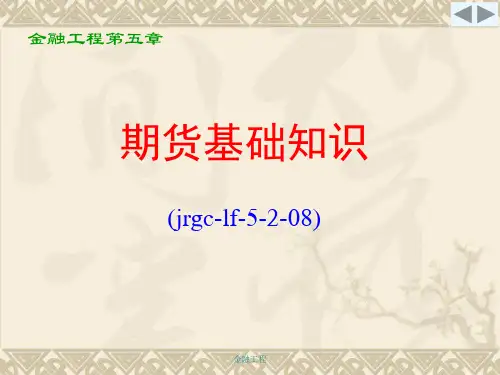
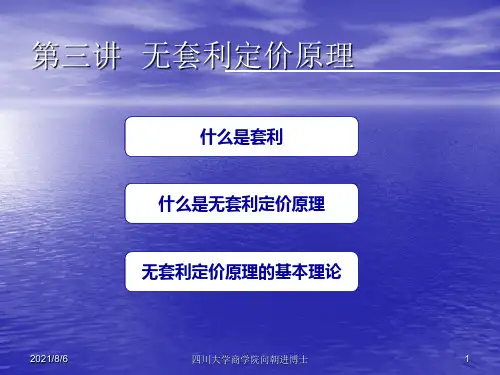
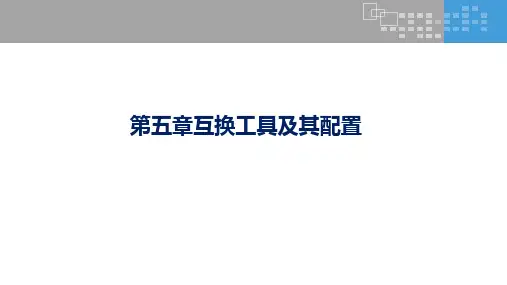
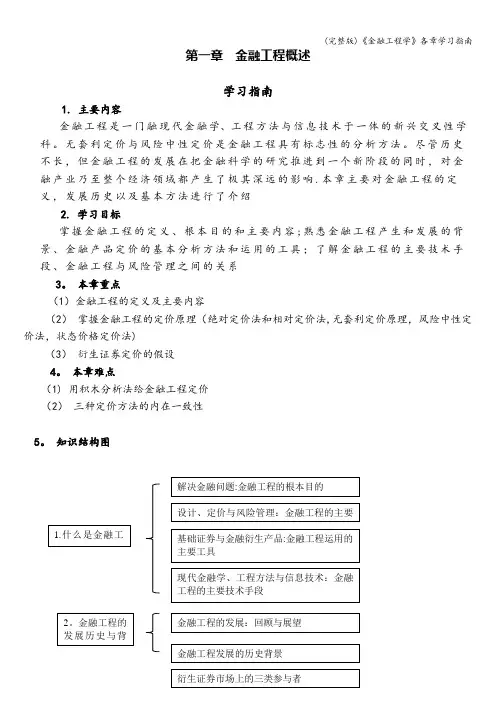
第一章 金融工程概述学习指南1. 主要内容 金融工程是一门融现代金融学、工程方法与信息技术于一体的新兴交叉性学科。
无套利定价与风险中性定价是金融工程具有标志性的分析方法。
尽管历史不长,但金融工程的发展在把金融科学的研究推进到一个新阶段的同时,对金融产业乃至整个经济领域都产生了极其深远的影响.本章主要对金融工程的定义,发展历史以及基本方法进行了介绍2. 学习目标掌握金融工程的定义、根本目的和主要内容;熟悉金融工程产生和发展的背景、金融产品定价的基本分析方法和运用的工具;了解金融工程的主要技术手段、金融工程与风险管理之间的关系3。
本章重点(1)金融工程的定义及主要内容(2) 掌握金融工程的定价原理(绝对定价法和相对定价法,无套利定价原理,风险中性定价法,状态价格定价法)(3) 衍生证券定价的假设4。
本章难点(1) 用积木分析法给金融工程定价(2) 三种定价方法的内在一致性5。
知识结构图6. 学习安排建议本章是整个课程的概论,介绍了有关金融工程的定义、发展历史和背景、基本原理等内容,是今后本课程学习的基础,希望同学们能多花一些时间理解和学习,为后续的学习打好基础。
● 预习教材第一章内容;● 观看视频讲解;● 阅读文字教材;● 完成学习活动和练习,并检查是否掌握相关知识点,否则重新学习相关内容。
● 了解感兴趣的拓展资源。
第二章 远期与期货概述学习指南 1。
主要内容远期是最基本、最古老的衍生产品。
期货则是远期的标准化.在这一章里,我们将了解远期和期货的基础知识,包括定义、主要类型和市场制度等,最后将讨论两者的异同点2. 学习目标掌握远期、期货合约的定义、主要种类;熟悉远期和期货的区别;了解远期和期货的产生和发展、交易机制3。
本章重点(1) 远期、期货的定义和操作(2) 远期、期货的区别4. 本章难点远期和期货的产生和发展、交易机制5. 知识结构图6. 学习安排建议本章主要对远期和期货的基础知识进行介绍,是之后进行定价、套期保值等操作的基础,建议安排1课时的时间进行学习。
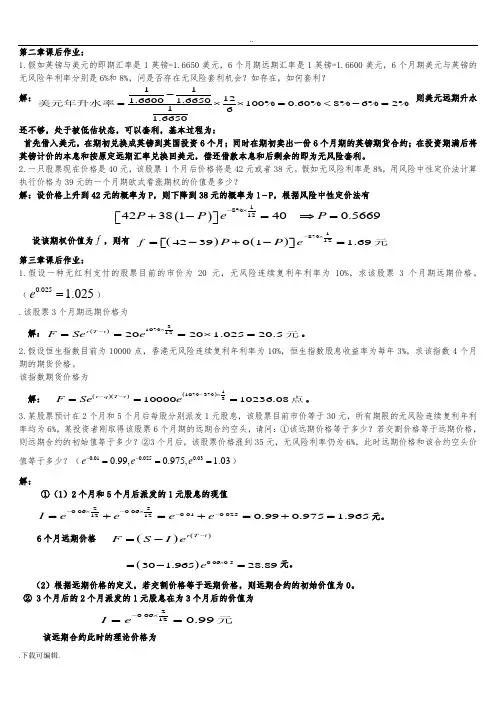
第二章课后作业:1.假如英镑与美元的即期汇率是1英镑=1.6650美元,6个月期远期汇率是1英镑=1.6600美元,6个月期美元与英镑的无风险年利率分别是6%和8%,问是否存在无风险套利机会?如存在,如何套利? 解:11121.6600 1.6650100%0.60%8%6%2%161.6650-=⨯⨯=<-=美元年升水率 则美元远期升水还不够,处于被低估状态,可以套利,基本过程为:首先借入美元,在期初兑换成英镑到英国投资6个月;同时在期初卖出一份6个月期的英镑期货合约;在投资期满后将英镑计价的本息和按原定远期汇率兑换回美元,偿还借款本息和后剩余的即为无风险套利。
2.一只股票现在价格是40元,该股票1个月后价格将是42元或者38元。
假如无风险利率是8%,用风险中性定价法计算执行价格为39元的一个月期欧式看涨期权的价值是多少?解:设价格上升到42元的概率为P ,则下降到38元的概率为1-P ,根据风险中性定价法有()18%1242381400.5669P P e P -⨯+-= ⇒=⎡⎤⎣⎦设该期权价值为f ,则有 ()()18%12423901 1.69f P P e -⨯=-+-= ⎡⎤⎣⎦元第三章课后作业:1.假设一种无红利支付的股票目前的市价为20元,无风险连续复利年利率为10%,求该股票3个月期远期价格。
(0.025 1.025e =).该股票3个月期远期价格为 解:()310%122020 1.02520.5r T t F Se e ⨯-===⨯= 元。
2.假设恒生指数目前为10000点,香港无风险连续复利年利率为10%,恒生指数股息收益率为每年3%,求该指数4个月期的期货价格。
该指数期货价格为解: ()()()110%3%31000010236.08r q T t F Se e -⨯--=== 点。
3.某股票预计在2个月和5个月后每股分别派发1元股息,该股票目前市价等于30元,所有期限的无风险连续复利年利率均为6%,某投资者刚取得该股票6个月期的远期合约空头,请问:①该远期价格等于多少?若交割价格等于远期价格,则远期合约的初始值等于多少?②3个月后,该股票价格涨到35元,无风险利率仍为6%,此时远期价格和该合约空头价值等于多少?(0.010.0250.030.99,0.975, 1.03e e e --===)解:①(1)2个月和5个月后派发的1元股息的现值250.060.060.010.02512120.990.975 1.965I e e e e -⨯-⨯--=+=+=+=元。
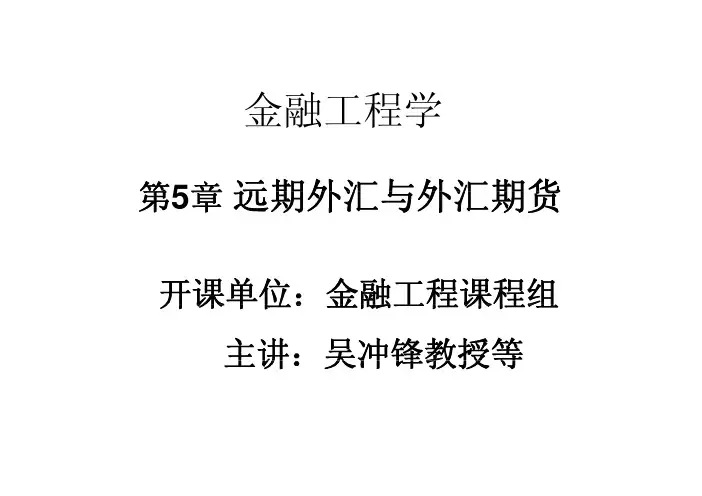
金融工程学第5章远期外汇与外汇期货开课单位:金融工程课程组主讲:吴冲锋教授等OTC衍生品市场交易情况单位:10亿美圆Global Futures and Options Volume by SectorIn millions of contractsIn millions of contractsTop 30 Derivatives Exchanges by Volume In millions of contractsTop 10 Commodities Contracts by VolumeIn millions of contractsIn millions of contracts5.1金融衍生产品51•含义:是指其价值依赖于基本(underlying)标的资产价格的金融工具,如远期,期货,期权,互换(掉期)等。
权互换等金融衍生产品的概念有关金融衍生品这概念还没有个明确有关“金融衍生品”这一概念还没有一个明确的定义,国内有不同的叫法,如:金融衍生商品,金融衍生产品,金融衍生工具,派生金融工具,金融派生品,金融衍生证券等,英文也有金融派生品金融衍生证券等英文也有a c a e at e st u e t、“Financial Derivative Instrument”“Derivative Financial 1nstrument”、“Derivative Security”等叫法,但含义都是相同的。
•衍生产品是英文(Derivatives)的中文意译。
其原意是派生物、衍生物的意思。
金融衍生产品通常是指从根本资产(Underlying Assets)派生出来的金融工具(产品)。
由于许多金融派生出来的金融工具(产品)由于许多金融衍生产品交易在资产负债表上没有相应科目,因而也被称为“资产负债表外交易(简称“表外交易”)。
表外交易:表外交易•由于各种衍生产品的交易并不在资产负债表中反应出来,所以对企业的影响是潜在的,而其爆发的后果却是非常严重的,有时甚至是致命的。
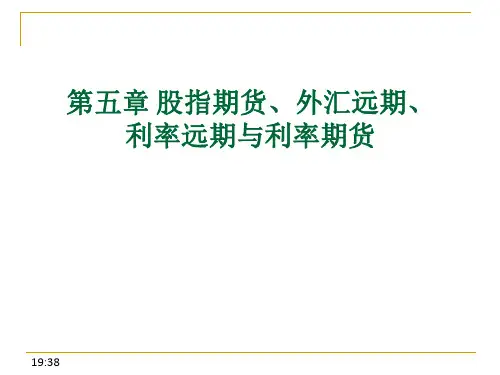
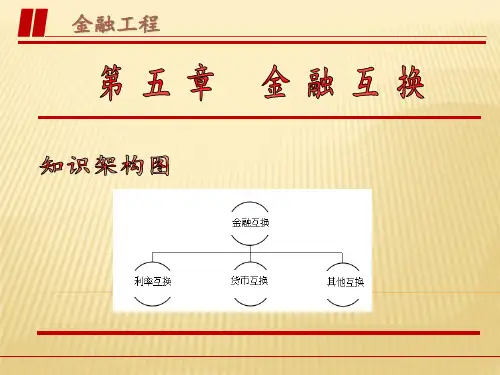
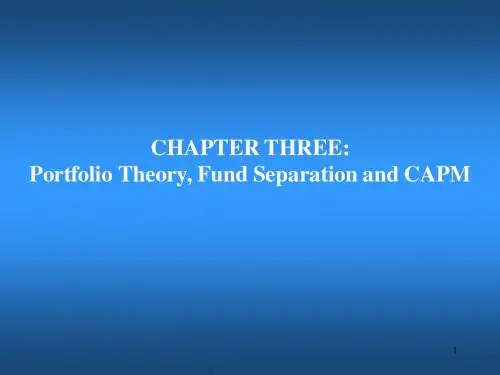
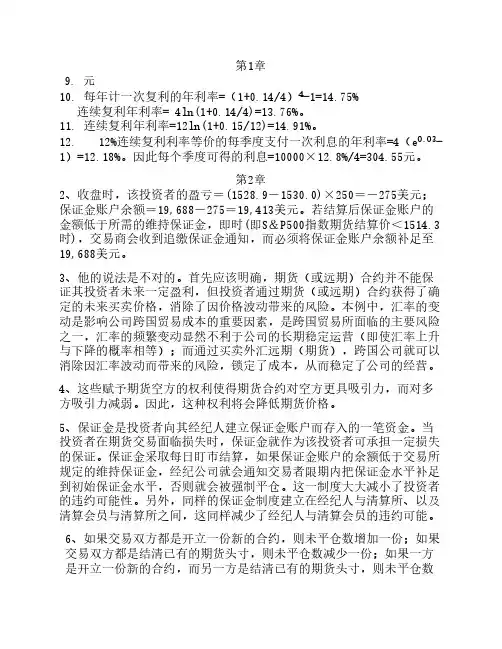
第1章9. 元10. 每年计一次复利的年利率=(1+0.14/4)4-1=14.75%连续复利年利率= 4ln(1+0.14/4)=13.76%。
11. 连续复利年利率=12ln(1+0.15/12)=14.91%。
12. 12%连续复利利率等价的每季度支付一次利息的年利率=4(e0.03-1)=12.18%。
因此每个季度可得的利息=10000×12.8%/4=304.55元。
第2章2、收盘时,该投资者的盈亏=(1528.9-1530.0)×250=-275美元;保证金账户余额=19,688-275=19,413美元。
若结算后保证金账户的金额低于所需的维持保证金,即时(即S&P500指数期货结算价<1514.3时),交易商会收到追缴保证金通知,而必须将保证金账户余额补足至19,688美元。
3、他的说法是不对的。
首先应该明确,期货(或远期)合约并不能保证其投资者未来一定盈利,但投资者通过期货(或远期)合约获得了确定的未来买卖价格,消除了因价格波动带来的风险。
本例中,汇率的变动是影响公司跨国贸易成本的重要因素,是跨国贸易所面临的主要风险之一,汇率的频繁变动显然不利于公司的长期稳定运营(即使汇率上升与下降的概率相等);而通过买卖外汇远期(期货),跨国公司就可以消除因汇率波动而带来的风险,锁定了成本,从而稳定了公司的经营。
4、这些赋予期货空方的权利使得期货合约对空方更具吸引力,而对多方吸引力减弱。
因此,这种权利将会降低期货价格。
5、保证金是投资者向其经纪人建立保证金账户而存入的一笔资金。
当投资者在期货交易面临损失时,保证金就作为该投资者可承担一定损失的保证。
保证金采取每日盯市结算,如果保证金账户的余额低于交易所规定的维持保证金,经纪公司就会通知交易者限期内把保证金水平补足到初始保证金水平,否则就会被强制平仓。
这一制度大大减小了投资者的违约可能性。
另外,同样的保证金制度建立在经纪人与清算所、以及清算会员与清算所之间,这同样减少了经纪人与清算会员的违约可能。
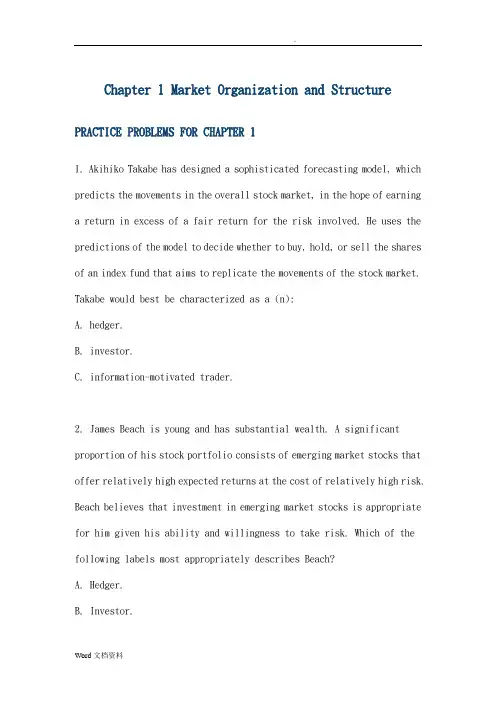
.Chapter 1 Market Organization and Structure PRACTICE PROBLEMS FOR CHAPTER 11. Akihiko Takabe has designed a sophisticated forecasting model, which predicts the movements in the overall stock market, in the hope of earning a return in excess of a fair return for the risk involved. He uses the predictions of the model to decide whether to buy, hold, or sell the shares of an index fund that aims to replicate the movements of the stock market. Takabe would best be characterized as a (n):A. hedger.B. investor.C. information-motivated trader.2. James Beach is young and has substantial wealth. A significant proportion of his stock portfolio consists of emerging market stocks that offer relatively high expected returns at the cost of relatively high risk. Beach believes that investment in emerging market stocks is appropriate for him given his ability and willingness to take risk. Which of the following labels most appropriately describes Beach?A. Hedger.B. Investor.C. Information-motivated trader.3. Lisa Smith owns a manufacturing company in the United States. Her company has sold goods to a customer in Brazil and will be paid in Brazilian real (BRL) in three months. Smith is concerned about the possibility of the BRL depreciating more than expected against the U.S. dollar (USD). Therefore, she is planning to sell three-month futures contracts on the BRL. The seller of such contracts generally gains when the BRL depreciates against the USD. If Smith were to sell these future contracts, she would most appropriately be described as a (n):A. hedger.B. investor.C. information-motivated trader.4. Which of the following is not a function of the financial system?A. To regulate arbitrageurs’ profits (excess returns).B. To help the economy achieve allocational efficiency.C. To facilitate borrowing by businesses to fund current operations.5. An investor primarily invests in stocks of publicly traded companies. The investor wants to increase the diversification of his portfolio. A friend has recommended investing in real estate properties. The purchaseof real estate would best be characterized as a transaction in the:A. derivative investment market.B. traditional investment market.C. alternative investment market.6. A hedge fund holds its excess cash in 90-day commercial paper and negotiable certificates of deposit. The cash management policy of the hedge fund is best described as using:A. capital market instruments.B. money market instruments.C. intermediate-term debt instruments.7. An oil and gas exploration and production company announces that it is offering 30 million shares to the public at $45.50 each. This transaction is most likely a sale in the:A. futures market.B. primary market.C. secondary market.8. Consider a mutual fund that invests primarily in fixed-income securities that have been determined to be appropriate given the fund’s investment goal. Which of the following is least likely to be a part ofthis fund?A. Warrants.B. Commercial paper.C. Repurchase agreements.9. A friend has asked you to explain the differences between open-end and closed-end funds. Which of the following will you most likely include in your explanation?A. Closed-end funds are unavailable to new investors.B. When investors sell the shares of an open-end fund, they can receive a discount or a premium to the fund’s net asset value.C. When selling shares, investors in an open-end fund sell the shares back to the fund whereas investors in a closed-end fund sell the shares to others in the secondary market.10. The usefulness of a forward contract is limited by some problems. Which of the following is most likely one of those problems?A. Once you have entered into a forward contract, it is difficult to exit from the contract.B. Entering into a forward contract requires the long party to deposit an initial amount with the short party.C. If the price of the underlying asset moves adversely from theperspective of the long party, periodic payments must be made to the short party.11. Tony Harris is planning to start trading in commodities. He has heard about the use of futures contracts on commodities and is learning more about them. Which of the following is Harris least likely to find associated with a futures contract?A. Existence of counterparty risk.B. Standardized contractual terms.C. Payment of an initial margin to enter into a contract.12. A German company that exports machinery is expecting to receive $10 million in three months. The firm converts all its foreign currency receipts into euros. The chief financial officer of the company wishes to lock in a minimum fixed rate for converting the $10 million to euro but also wants to keep the flexibility to use the future spot rate if it is favorable. What hedging transaction is most likely to achieve this objective?A. Selling dollars forward.B. Buying put options on the dollar.C. Selling futures contracts on dollars.13. A book publisher requires substantial quantities of paper. The publisher and a paper producer have entered into an agreement for the publisher to buy and the producer to supply a given quantity of paper four months later at a price agreed upon today. This agreement is a:A. futures contract.B. forward contract.C. commodity swap.14. The Standard & Poor’s Depos itary Receipts (SPDRs) is an investment that tracks the S&P 500 stock market index. Purchases and sales of SPDRs during an average trading day are best described as:A. primary market transactions in a pooled investment.B. secondary market transactions in a pooled investment.C. secondary market transactions in an actively managed investment.15. The Standard & Poor’s Depositary Receipts (SPDRs) is an exchange-traded fund in the United States that is designed to track the S&P 500 stock market index. The current price of a share of SPDRs is $113.A trader has just bought call options on shares of SPDRs for a premium of $3 per share. The call options expire in five months and have an exercise price of $120 per share. On the expiration date, the trader will exercise the call options (ignore any transaction costs) if and only if the sharesof SPDRs are trading:A. below $120 per share.B. above $120 per share.C. above $123 per share.16. Which of the following statements about exchange-traded funds is most correct?A. Exchange-traded funds are not backed by any assets.B. The investment companies that create exchange-traded funds are financial intermediaries.C. The transaction costs of trading shares of exchange-traded funds are substantially greater than the combined costs of trading the underlying assets of the fund.17. Jason Schmidt works for a hedge fund and he specializes in finding profit opportunities that are the result of inefficiencies in the market for convertible bonds—bonds that can be converted into a predetermined amount of a company’s common stock. Schmidt tries to find convertibles that are priced inefficiently relative to the underlying stock. The trading strategy involves the simultaneous purchase of the convertible bond and the short sale of the underlying common stock. The above process could best be described as:A. hedging.B. arbitrage.C. securitization.18. Pierre-Louis Robert just purchased a call option on shares of the Michelin Group. A few days ago he wrote a put option on Michelin shares. The call and put options have the same exercise price, expiration date, and number of shares underlying. Considering both positions, Robert’s exposure to the risk of the stock of the Michelin Group is:A. long.B. short.C. neutral.19. An online brokerage firm has set the minimum margin requirement at 55 percent. What is the maximum leverage ratio associated with a position financed by this minimum margin requirement?A. 1.55.B. 1.82.C. 2.22.20. A trader has purchased 200 shares of a non-dividend-paying firm on margin at a price of $50 per share. The leverage ratio is 2.5. Six monthslater, the trader sells these shares at $60 per share. Ignoring the interest paid on the borrowed amount and the transaction costs, what was the return to the trader during the six-month period?A. 20 percent.B. 33.33 percent.C. 50 percent.21. Jason Williams purchased 500 shares of a company at $32 per share. The stock was bought on 75 percent margin. One month later, Williams had to pay interest on the amount borrowed at a rate of 2 percent per month. At that time, Williams received a dividend of $0.50 per share. Immediately after that he sold the shares at $28 per share. He paid commissions of $10 on the purchase and $10 on the sale of the stock. What was the rate of return on this investment for the one-month period?A. −12.5 percent.B. –15.4 percent.C. –50.1 percent.22. Caroline Rogers believes the price of Gamma Corp. stock will go down in the near future. She has decided to sell short 200 shares of Gamma Corp. at the current market price of €47. The initial margin requirement is 40 percent. Which of the following is an appropriate statement regardingthe margin requirement that Rogers is subject to on this short sale?A. She will need to c ontribute €3,760 as margin.B. She will need to contribute €5,640 as margin.C. She will only need to leave the proceeds from the short sale as deposit and does not need to contribute any additional funds.23. The current price of a stock is $25 per share. You have $10,000 to invest. You borrow an additional $10,000 from your broker and invest $20,000 in the stock. If the maintenance margin is 30 percent, at what price will a margin call first occur?A. $9.62.B. $17.86.C. $19.71.24. You have placed a sell market-on-open order—a market order that would automatically be submitted at the market’s open tomorrow and would fill at the market price. Your instruction, to sell the shares at the market open, is a(n):A. execution instruction.B. validity instruction.C. clearing instruction.25. A market has the following limit orders standing on its book for a particularstock. The bid and ask sizes are number of shares in hundreds.What is the market?A. 9.73 bid, offered at 10.14.B. 9.81 bid, offered at 10.10.C. 9.95 bid, offered at 10.02.26. Consider the following limit order book for a stock. The bid and ask sizes arenumber of shares in hundredsA new buy limit order is placed for 300 shares at ¥123.40. This limit ordersaid to:A. take the market.B. make the market.C. make a new market.27. Currently, the market in a stock is "$54.62 bid, offered at $54.71."A new selllimit order is placed at $54.62. This limit order is said to:A. take the market.B. make the market.C. make a new market.28. Jim White has sold short 100 shares of Super Stores at a price of$42 per share. He has also simultaneously placed a "good-till-cancelled, stop 50, limit 55 buy" order. Assume that if the stop condition specified by White is satisfied and the order becomes valid, it will get executed. Excluding transaction costs, what is the maximum possible loss that White can have?A. $800.B. $1,300.C. Unlimited.29. You own shares of a company that are currently trading at $30 a share. Yourtechnical analysis of the shares indicates a support level of $27.50. That is, if the price of the shares is going down, it is more likely to stay above this level rather than fall below it. If the price does fall below this level, however, you believe that the price may continue to decline. You have no immediate intent to sell the shares but are concerned about the possibility of a huge loss if the share price declines below the support level. Which of the following types of orders could you place to most appropriately address your concern?A. Short sell order.B. Good-till-cancelled stop sell order.C. Good-till-cancelled stop buy order.30. In an underwritten offering, the risk that the entire issue may not be sold to the public at the stipulated offering price is borne by the:A. issuer.B. investment bank.C. buyers of the part of the issue that is sold.31 . A British company listed on the Alternative Investment Market of theLondon Stock Exchange, announced the sale of 6,686,665 shares to a small group of qualified invest ors at £0.025 per share. Which of the following best describesthis sale?A. Shelf registration.B. Private placement.C. Initial public offering.32. A German publicly traded company, to raise new capital, gave its existing shareholders the opportunity to subscribe for new shares. The existing shareholders could purchase two new shares at a subscription price of €4.58 per share for every 15 shares held. This is an example of a(n):A. rights offering.B. private placement.C. initial public offering.33. Consider an order-driven system that allows hidden orders. The following four sell orders on a particular stock are currently in the system's limit order book. Based on the commonly used order precedence hierarchy, which of these orders will have precedence over others?A. Order I (time of arrival of 9:52:01 ).B. Order II (time of arrival of 9:52:08).C. Order III (time of arrival of 9:53:04)34. Zhenhu Li has submitted an immediate-or-cancel buy order for 500 shares of a company at a limit price of CNY 74.25. There are two sell limit orders standing in that stock's order book at that time. One is for 300 shares at a limit price of CNY 74.30 and the other is for 400 shares at a limit price of CNY 74.35. How many shares in Li's order would get cancelled?A. None (the order would remain open but unfilled).B. 200 (300 shares would get filled).C. 500 (there would be no fill).35. A market has the following limit orders standing on its book for a particular stock:Ian submits a day order to sell 1,000 sha res, limit £19.83. Assuming that no more buy orders are submitted on that day after Ian submits his order, what would be Ian's average trade price?A. £19.70.B. £19.92.C. £20.05.36. A financial analyst is examining whether a country's financial market is well functioning. She finds that the transaction costs in this market are low and trading volumes are high. She concludes that the market is quite liquid. In such a market:A. traders will find it hard to make use of their information.B. traders will find it easy to trade and their trading will make the market less informationally efficient.C. traders will find it easy to trade and their trading will make the market more informationally efficient.37. The government of a country whose financial markets are in an early stage of development has hired you as a consultant on financial market regulation. Your first task is to prepare a list of the objectives of market regulation. Which of the following is least likely to be included in this list of objectives?A. Minimize agency problems in the financial markets.B. Ensure that financial markets are fair and orderly.C. Ensure that investors in the stock market achieve a rate of return that is atleast equal to the risk-free rate of return.Chapter 2 Portfolio Management: An Overview PRACTICE PROBLEMS FOR CHAPTER 21. Investors should use a portfolio approach to:A. reduce risk.B. monitor risk.C. eliminate risk.2. Which of the following is the best reason for an investor to be concerned with the composition of a portfolio?A. Risk reduction.B. Downside risk protection.C. Avoidance of investment disasters.3. With respect to the formation of portfolios, which of the following statements is most accurate?A. Portfolios affect risk less than returns.B. Portfolios affect risk more than returns.C. Portfolios affect risk and returns equally.4. Which of the following institutions will on average have the greatest need for liquidity?A. Banks.B. Investment companies.C. Non-life insurance companies.5. Which of the following institutional investors will most likely have the longest time horizon?A. Defined benefit plan.B. University endowment.C. Life insurance company.6. A defined benefit plan with a large number of retirees is likely to have a high need forA. income.B. liquidity.C. insurance.7. Which of the following institutional investors is most likely to manage investments in mutual funds?A. Insurance companies.B. Investment companies.C. University endowments.8. With respect to the portfolio management process, the asset allocation is determined in the:A. planning step.B. feedback step.C. execution step9. The planning step of the portfolio management process is least likely to include an assessment of the client'sA. securities.B. constraints.C. risk tolerance.10. With respect to the portfolio management process, the rebalancing ofa portfolio's composition is most likely to occur in the:A. planning step.B. feedback step.C. execution step.11. An analyst gathers the following information for the asset allocations of three portfolios:Which of the portfolios is most likely appropriate for a client who has a high degree of risk tolerance?A. Portfolio 1.B. Portfolio 2.C. Portfolio 3.12. Which of the following investment products is most likely to trade at their net asset value per share?A. Exchange traded funds.B. Open-end mutual funds.C. Closed-end mutual funds.13. Which of the following financial products is least likely to have a capital gain distribution?A. Exchange traded funds.B. Open-end mutual funds.C. Closed-end mutual funds.14. Which of the following forms of pooled investments is subject to the least amount of regulation?A. Hedge funds.B. Exchange traded funds.C. Closed-end mutual funds.15. Which of the following pooled investments is most likely characterized by a few large investments?A. Hedge funds.B. Buyout funds.C. Venture capital funds.Chapter 3 Portfolio Risk and Return: Part I PRACTICE PROBLEMS FOR CHAPTER 31. An investor purchased 100 shares of a stock for $34.50 per share at the beginning of the quarter. If the investor sold all of the shares for $30.50 per share after receiving a $51.55 dividend payment at the end of the quarter, the holding period return is closest to:A. - 13.0%.B. - 11.6%.C. - 10.1%.2. An analyst obtains the following annual rates of return for a mutual fund:The fund's holding period return over the three-year period is closest to:A. 0.18%.B. 0.55%.C. 0.67%.3. An analyst observes the following annual rates of return for a hedge fund:The hedge fund's annual geometric mean return is closest to:A. 0.52%.B. 1.02%.C. 2.67%.4. Which of the following return calculating methods is best for evaluating theannualized returns of a buy-and-hold strategy of an investor who has made annual deposits to an account for each of the last five years?A. Geometric mean return.B. Arithmetic mean return.C. Money-weighted return.5. An investor evaluating the returns of three recently formed exchange-traded funds gathers the following information:The ETF with the highest annualized rate of return is:A. ETF 1.B. ETF 2.C. ETF 3.6. With respect to capital market theory, which of the following asset characteristics is least likely to impact the variance of an investor's equally weighted portfolio?A. Return on the asset.B. Standard deviation of the asset.C. Covariances of the asset with the other assets in the portfolio.7. A portfolio manager creates the following portfolio:If the correlation of returns between the two securities is 0.40, the expected standard deviation of the portfolio is closest to:A. 10.7%.B. 11.3%.C. 12.1%.8. A portfolio manager creates the following portfolio:If the covariance of returns between the two securities is - 0.0240, the expected standard deviation of the portfolio is closest to:A. 2.4%.B. 7.5%.C. 9.2%.The following information relates to Questions 9-10A portfolio manager creates the following portfolio:9. If the standard deviation of the portfolio is 14.40%, the correlation between the two securities is equal to:A. - 1.0.B. 0.0.C. 1.0.10. If the standard deviation of the portfolio is 14.40%, the covariance between the two securities is equal to:A. 0.0006.B. 0.0240.C. 1.0000.The following information relates to Questions 11-14An analyst observes the following historic geometric returns:11 . The real rate of return for equities is closest to:A. 5.4%.B. 5.8%.C. 5.9%.12. The real rate of return for corporate bonds is closest to:A. 4.3%.B. 4.4%.C. 4.5%.13. The risk premium for equities is closest to:A. 5.4%.B. 5.5%.C. 5.6%.14. The risk premium for corporate bonds is closest to:A. 3.5%.B. 3.9%.C. 4.0%.15. With respect to trading costs, liquidity is least likely to impact the:A. stock price.B. bid-ask spreads.C. brokerage commissions.16. Evidence of risk aversion is best illustrated by a risk-return relationship that is:A. negative.B. neutral.C. positive.17. With respect to risk-averse investors, a risk-free asset will generatea numerical utility that is:A. the same for all individuals.B. positive for risk-averse investors.C. equal to zero for risk seeking investors18. With respect to utility theory, the most risk-averse investor will have an indifference curve with the:A. most convexity.B. smallest intercept value.C. greatest slope coefficient.19. With respect to an investor's utility function expressedas:21=E(r)-2u A , which of the following values for the measure for riskaversion has the least amount of risk aversion?A. - 4.B. 0.C. 4.The following information relates to Questions 20-23A financial planner has created the following data to illustrate the application of utility theory to portfolio selection:20. A risk-neutral investor is most likely to choose:A. Investment 1.B. Investment 2.C. Investment 3.ExpectedStandard Deviation (% )28153021. If an investor's utility function is expressed as U = E(r) ~A& and the measure for risk aversion has a value of- 2, the risk-seeking investor is most likely to choose:A. Investment 2.B. Investment 3.C. Investment 4.22. If an investor's utility function is expressed as U = E(r) - ~A& and the measure for risk aversion has a value of2, the risk-averse investor is most likely to choose:A. Investment 1.B. Investment 2.C. Investment 3.23. If an investor's utility function is expressed as U =E(r) - ~A& and the measure for risk aversion has a value of4, the risk-averse investor is most likely to choose:A. Investment 1.B. Investment 2.C. Investment 3.24. With respect to the mean-variance portfolio theory, the capital allocation line, CAL, is the combination of the risk-free asset and a portfolio of all:A. risky assets.B. equity securities.C. feasible investments.25. Two individual investors with different levels of risk aversion will have optimalportfolios that are:A. below the capital allocation line.B. on the capital allocation line.C. above the capital allocation line.The following information relates to Questions 26-28A portfolio manager creates the following portfolio:26. If the portfolio of the two securities has an expected return of15%, the proportion invested in Security 1 is:A. 25%.B. 50%.C. 75%.27. If the correlation of returns between the two securities is - 0.15, the expected standard deviation of an equal-weighted portfolio is closest to:A. 13.04%.B. 13.60%.C. 13.87%.28. If the two securities are uncorrelated, the expected standard deviation of an equal-weighted portfolio is closest to:A. 14.00%.B. 14.14%.C. 20.00%.29. As the number of assets in an equally-weighted portfolio increases, the contribution of each individual asset's variance to the volatility of the portfolio:A. increases.B. decreases.C. remains the same.30. With respect to an equally-weighted portfolio made up of a large number of assets, which of the following contributes the most to the volatility of the portfolio?A. Average variance of the individual assets.B. Standard deviation of the individual assets.C. Average covariance between all pairs of assets.31. The correlation between assets in a two-asset portfolio increases during a market decline. If there is no change in the proportion of each asset held in the portfolio or the expected standard deviation of the individual assets, the volatility of the portfolio is most likely to:A. increase.B. decrease.C. remain the same.The following information relates to Questions 32-34An analyst has made the following return projections for each of three possible outcomes with an equal likelihood of occurrence:32. Which pair of assets is perfectly negatively correlated?A. Asset 1 and Asset 2.B. Asset 1 and Asset 3.C. Asset 2 and Asset 3.33. If the analyst constructs two-asset portfolios that areequally-weighted, which pair of assets has the lowest expected standarddeviation?A. Asset 1 and Asset 2.B. Asset 1 and Asset 3.C. Asset 2 and Asset 3.34. If the analyst constructs two-asset portfolios that are equally weighted, which pair of assets provides the least amount of risk reduction?A. Asset 1 and Asset 2.B. Asset 1 and Asset 3.C. Asset 2 and Asset 3.35. Which of the following statements is least accurate? The efficient frontier is the set of all attainable risky assets with the:A. highest expected return for a given level of risk.B. lowest amount of risk for a given level of return.C. highest expected return relative to the risk-free rate.36. The portfolio on the minimum-variance frontier with the lowest standard deviation is:A. unattainable.B. the optimal risky portfolio.C. the global minimum-variance portfolio.37. The set of portfolios on the minimum-variance frontier that dominates all sets of portfolios below the global minimum-variance portfolio is the:A. capital allocation line.B. Markowitz efficient frontier.C. set of optimal risky portfolios.38. The dominant capital allocation line is the combination of the risk-free asset and the:A. optimal risky portfolio.B. levered portfolio of risky assets.C. global minimum-variance portfolio.39. Compared to the efficient frontier of risky assets, the dominant capital allocation line has higher rates of return for levels of risk greater than the optimal risky portfolio because of the investor's ability to:A. lend at the risk-free rate.B. borrow at the risk-free rate.C. purchase the risk-free asset.40. With respect to the mean-variance theory, the optimal portfolio is determined by each individual investor's:A. risk-free rate.B. borrowing rate.C. risk preference.Chapter 4 Portfolio Risk and Return: Part II PRACTICE PROBLEMS FOR CHAPTER 41. The line depicting the risk and return of portfolio combinations ofa risk-free asset and any risky asset is the:A. security market line.B. capital allocation line.C. security characteristic line.2. The portfolio of a risk-free asset and a risky asset has a better risk-return tradeoff than investing in only one asset type because the correlation between the risk-free asset and the risky asset is equal to:A. - 1.0.B. 0.0.C. 1.0.3. With respect to capital market theory, an investor's optimal portfolio is the combination of a risk-free asset and a risky asset with the highest:A. expected return.B. indifference curve.C. capital allocation line slope.。